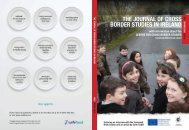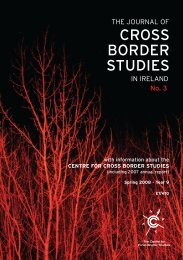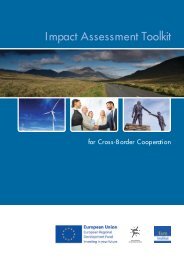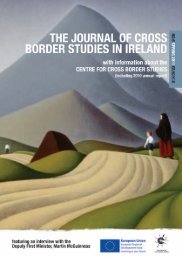improving government service delivery to minority ethnic ... - NCCRI
improving government service delivery to minority ethnic ... - NCCRI
improving government service delivery to minority ethnic ... - NCCRI
Create successful ePaper yourself
Turn your PDF publications into a flip-book with our unique Google optimized e-Paper software.
<strong>improving</strong><br />
<strong>government</strong><br />
<strong>service</strong><br />
<strong>delivery</strong><br />
<strong>to</strong> <strong>minority</strong><br />
<strong>ethnic</strong> groups<br />
Executive Summary 14_15<br />
Employment<br />
For many the problematic issues around employment are unequal rights such as contracts not being issued,<br />
unequal pay with low wages, longer hours, no right <strong>to</strong> sick leave and/or pay and unfair dismissal. In addition the<br />
issue of accommodation being tied <strong>to</strong> employment was also raised as problematic.<br />
Housing<br />
In regard <strong>to</strong> housing, issues of multiple occupancy were raised. Other respondents were also aware of rent<br />
being increased in areas with a high migrant worker population.<br />
In conclusion this chapter finds that the <strong>service</strong> areas focused on in Northern Ireland show examples of<br />
interesting initiatives and approaches but these examples have <strong>to</strong> become more mainstreamed <strong>to</strong> begin <strong>to</strong><br />
have a real impact on outcomes. Language barriers have emerged as a key issue for many interviewees and<br />
some <strong>service</strong> providers are tackling this through initiatives such as the Regional Interpreting Service and the<br />
employment of Bilingual Advocacy Workers in the area of health.<br />
The first step in <strong>improving</strong> data collection would be <strong>to</strong> reassess the <strong>ethnic</strong>ity categories <strong>to</strong> be more reflective<br />
of the current population therefore expanding the ‘White’ category and including questions on country of birth.<br />
Within all the sec<strong>to</strong>rs it is of concern that data collection was not considered essential for <strong>service</strong> <strong>delivery</strong>.<br />
It is encouraging <strong>to</strong> note that there were examples of engagement between public authorities and <strong>minority</strong><br />
<strong>ethnic</strong> groups. The groups being formed, such as the Ballymena Inter Agency Forum, are examples of how<br />
public authorities are trying <strong>to</strong> engage with communities and ensure that their <strong>service</strong> is being cus<strong>to</strong>mer led.<br />
Interviews and focus groups with people from <strong>minority</strong> <strong>ethnic</strong> backgrounds and NGOs revealed that many<br />
people feel <strong>service</strong>s have improved for <strong>minority</strong> <strong>ethnic</strong> groups and that needs are now starting <strong>to</strong> be met.<br />
However it must be highlighted that standards of <strong>service</strong> varied with some public authorities failing <strong>to</strong> deliver in<br />
some aspects.<br />
Chapter 3 presents the Scotland Research Findings from Wendy Davies and Ashok Ohri, Organisation and<br />
Social Development Consultants Limited. The methodology for the Scottish chapter of this research involved a<br />
combination of desk-<strong>to</strong>p research and individual interviews.<br />
The Race Relations Act 1976 (RRA) makes it unlawful <strong>to</strong> discriminate on the grounds of colour, race, nationality<br />
(including citizenship), or <strong>ethnic</strong> or national origin in employment, education, housing and the provision of<br />
goods, facilities and <strong>service</strong>s. The Race Relations (Amendment) Act 2000 (RRAA) places enforceable duties<br />
on public bodies <strong>to</strong> eliminate unlawful discrimination, promote equality of opportunity, and promote good<br />
relations between persons of different racial groups. The Race Relations Act 1976 (Amendment) Regulations<br />
2003 (‘the Race Regulations’) incorporated the EU Race Directive in<strong>to</strong> UK law by making changes <strong>to</strong> the Race<br />
Relations Act 1976.<br />
A Review of Race Equality in Scotland, published in November 2005, introduced a number of measures aimed<br />
at reducing discrimination and challenging racism. The Review also announced that there would be a Race<br />
Equality Strategy and Action Plan announced in the autumn of 2006.<br />
There is a long his<strong>to</strong>ry of immigration in Scotland and a Gypsy/Traveller community. The 2001 Census found<br />
the <strong>minority</strong> <strong>ethnic</strong> population in Scotland <strong>to</strong> be 2% of the <strong>to</strong>tal population. Scotland’s population is predicted<br />
<strong>to</strong> fall by 10% by 2042. Further, Scotland’s population is ageing rapidly. To address this issue, the Executive<br />
have launched a Fresh Talent initiative <strong>to</strong> entice people <strong>to</strong> live and work in Scotland.
















